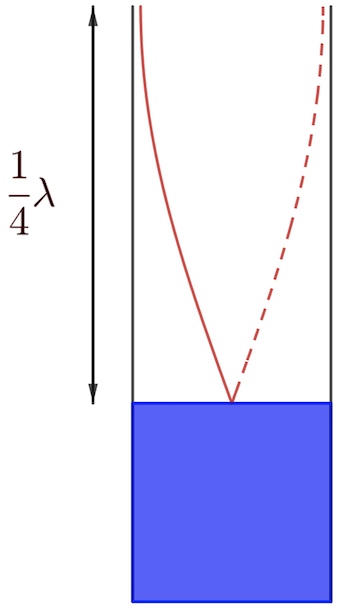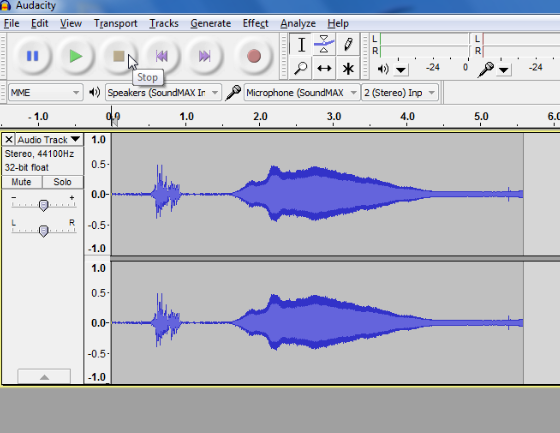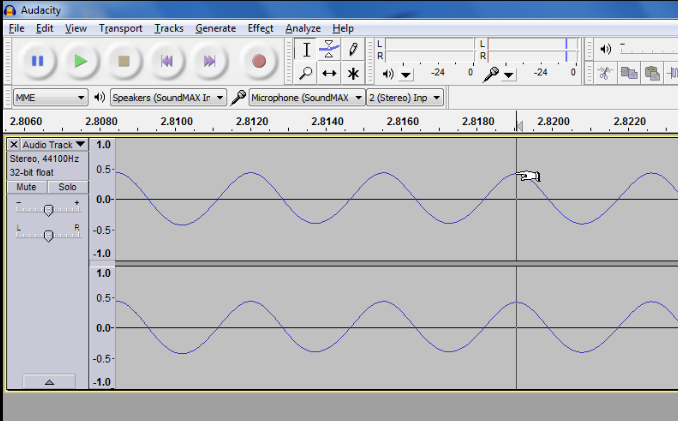This GeoGebra applet was modified from an existing applet to show the relationship between the pressure-distance and displacement-distance graph of a progressive longitudinal wave.
A physics demonstration on how to measure the speed of sound in air using Audacity, an open source audio recording software. There are Windows and Mac versions of this free software, and even a portable version that can run off a flash drive without needing to be installed on a computer (for school systems with stricter measures regarding installing of software).
The sound is reflected along a long hollow tube that somehow, existed in our school’s laboratory. The two sound signals were picked up using a clip-on microphone attached to the open end of the tube and plugged into the laptop. I used my son’s castanet which gives a crisp sound and hence, a simple waveform that will not have the echo overlapping with the generated sound. The timing at which the sound signals were first detected were read and subtracted to obtain the time taken for the wave to travel up and down the 237 cm tube.
The value of the speed of sound calculated is 356 m/s, which is a bit on the high side due to the temperature of 35°C and relative humidity of between 60-95% when the reading was carried out.
If you are interested, you can check out how the software can be used to determine the frequency of a tuning fork.
Audacity is a free audio recording and editing software downloadable from http://audacity.sourceforge.net. It is cross-platform meaning you can run it on PC or Mac.
Once you have the software installed, you can try out some of its simpler functions, such as recording and playing back. You can also generate tones of known frequencies, which will be useful for experiments such as using stationary waves to determine the speed of sound in air.
Frequency and pitch
The first activity serves as an introduction to the software and can be easily carried out. All you need is a computer with Audacity installed and a microphone connected to it. Tuning forks of different frequencies will be best for this activity because of the simple and pure waveforms generated. A regular wave pattern can also be recorded with the help of a musical instrument such as a guitar or by singing a note.
To make a sound with the tuning fork, strike it against something hard such as the heel of your hand. The two prongs of the fork, known as “tines,” will then vibrate with a fixed frequency, thus generating a waveform with a displacement that is almost sinusoidal. Place this tuning fork next to the microphone and you should see a densely packed waveform like the following:
Zoom into the peaks recorded by clicking on the peaks of interest and pressing Ctrl 1 for Windows or Command 1 for Mac. You should observe a repeated pattern in the waveform.
By reading off the time difference on the horizontal axis between two peaks, you can measure the period of the wave. Using
In the above graph, the period is 2.8190-2.8155 = 0.0035s. The frequency of the tuning fork used is given by
Outline for Measuring the Speed of Sound Using a Tuning Fork and a Hollow Pipe Submerged in Water:
- Equipment Setup:
- Obtain a tuning fork of known frequency and a hollow pipe that can be partially submerged in a column of water.
- The pipe should be open at the top and closed at the bottom by the water surface.
- Strike the Tuning Fork:
- Strike the tuning fork on a soft surface to make it vibrate. This produces a sound wave of a specific frequency, known as the fundamental frequency of the tuning fork.
- Submerge the Hollow Pipe:
- Submerge the hollow pipe vertically in a large container filled with water. The length of the air column inside the pipe can be adjusted by raising or lowering the pipe in the water.
- Create Resonance:
- Hold the vibrating tuning fork above the open end of the pipe. Slowly raise or lower the pipe in the water while listening for the loudest sound, which indicates resonance.
- Resonance occurs when the length of the air column in the pipe is such that it forms a standing wave with the frequency of the tuning fork. This usually happens when the length of the air column is a quarter of the wavelength of the sound wave.
- Measure the Air Column Length:
- When resonance is achieved (indicated by a significant increase in sound amplitude), measure the length of the air column from the water surface to the top of the pipe. This length corresponds to one-quarter of the wavelength of the sound wave in air.
- Calculate the Wavelength:
- Multiply the measured length by 4 to determine the wavelength of the sound wave.
- Determine the Speed of Sound:
- Use the formula Speed of Sound = Frequency × Wavelength (
- Use the formula Speed of Sound = Frequency × Wavelength (

Explanation:
The speed of sound in air can be measured using the relationship between the frequency of the sound wave and its wavelength, which are connected by the speed of sound. When the tuning fork vibrates, it creates sound waves that travel through the air. When these waves enter the hollow pipe, they reflect off the water surface, and at certain lengths, they create a resonance condition, amplifying the sound. The resonant length corresponds to one-quarter of the wavelength because the pipe is effectively closed at the bottom (by the water), forming a node at the water surface and an antinode at the open end. By measuring this length and knowing the frequency of the tuning fork, the speed of sound can be calculated.

